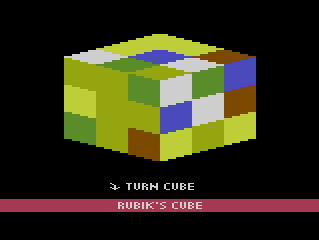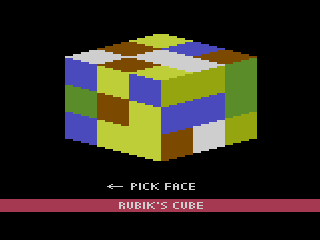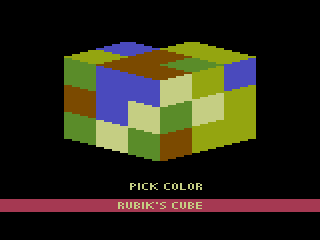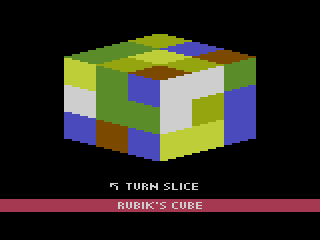|
|
3-D Rubik's Cube
|
Name:
|
3-D Rubik's Cube |
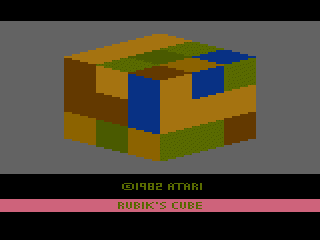 |
| Company: | Atari | |
|
Model #:
|
N/A | |
|
Programmer:
|
Peter C. Niday | |
| Year: | 1982 | |
|
Released?
|
No
|
|
|
Notes:
|
First and only prototype surfaced in 2002 |
Rubik's Cube (which we'll refer to as 3-D Rubik's Cube to
keep from confusing it with the 1984 Atari re-release of Atari
Video Cube) is a curious oddity with an interesting back
story. Programmer Peter Niday was working as a tester in
Atari's labs when he decided to develop a 3-D Rubik's Cube game
in his spare time. Atari managers eventually saw his
little project and decided that he was too good to be working as
a mere tester. Peter was then promoted to a full-fledged
programmer a short time later. However instead of finishing up
his little 3-D experiment, Atari threw him onto the higher
priority Sorcerers Apprentice project instead.
All was not lost for 3-D Rubik's cube however. Atari
still had plans on releasing the game, but only as a two-fer
with another Rubik's Cube inspired game called Atari video
Cube (developed by GCC). Why Atari decided that these
games needed to be combined is unknown but they may have
figured that the market wasn't strong enough for two separate
Rubik's Cube themed games. So why wasn't this Rubik's
Cube themed mega cart released? As it turns out, Atari
couldn't figure out how the player would choose between the
two games. 3-D Rubik's Cube used the select switch so
that was out of the question, and for technical reasons a menu
system wasn't feasible. The two solutions Atari came up
with were to either hold down the select and reset switches at
the same time, or to have a second joystick plugged in.
However in the end marketing decided that it was easier to
just release one of the games and Atari Video Cube was chosen
over 3-D Rubik's Cube. This was most likely due to AVC
being having a bit more action than the pure puzzle nature of
3-D Rubik's Cube.
As you probably already guessed, 3-D Rubik's Cube is a computer simulation of the old Rubik's Cube puzzle that was all the rage back in the mid 80's. Unlike Atari Video Cube, 3-D Rubik's Cube is displayed in three dimensions so the player can see three of the cube faces at once rather than one. This makes solving the cube much easier as the player doesn't have to have a super human memory to remember the other five sides. Since 3-D Rubik's Cube is shown in a proper 3-D perspective, players can manipulate the cube just like they would in the real world. This is a far cry from Atari Video Cube's gameplay which involved an elf running over squares, picking up and dropping off colors (what the hell were they thinking?).
3-D Rubik's Cube as two different play modes: Normal and Cheat (toggled by the left difficulty switch). In normal mode the player can rotate the cube in any one of four directions until the desired side appears. Once a side has been selected, the player can then rotate the individual slices (rows and columns) until they think they have it in the right position. The player repeats this process until the cube is solved (or they go insane). In cheat mode, the player can actually set the colors on the cube to what ever they desire. Players can even create impossible to solve cubes by placing too much of one color or not enough of another. Due to the strange nature of this "cheat mode", people have begun to speculate it may have been put in for debugging purposes. It is unknown if it would have been included in the final release.
As if this prototype wasn't amazing enough, 3-D Rubik's Cube even includes a solve mode. If the player gets too frustrated they can choose to have the computer solve the cube for them (Yes the 2600 IS smarter than you!). However players cannot activate the solve mode if the colors have been altered in cheat mode, so you'll have to put them back into their original configuration first. This was done to prevent players from building unsolvable cubes with the cheat mode (there's always one kid who has to ruin it for everybody). Unfortunately there is no way to automatically restore the colors, so it's up to the player to remember what they changed. The solve mode is actually a step-by-step demonstration (controlled by the fire button), and shows the player each move it is making. This way players can learn what they did wrong and become better Rubik's Cube solvers (good luck beating those guys who solve them in 10 seconds flat).
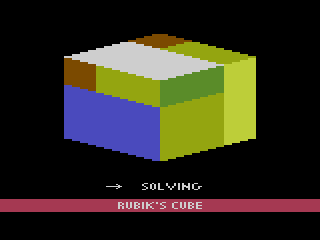
The graphics in 3-D Rubik's Cube are simply amazing. While they may have some rough jagged edges, each square on the cube is displayed at the proper angle to give a true 3-D perspective. It is theorized that the cube is made up of a combination of playfield and character graphics, which allows multiple colored squares to be shown on the same scanline. The sound effects are pretty standard for a puzzle game, consisting of a beep when rotating the cube, a little victory song upon solving the cube, and a nasty crashing sound when the solve mode fails (due to misuse of the cheat mode). It's obvious that a lot of hard work went into this game
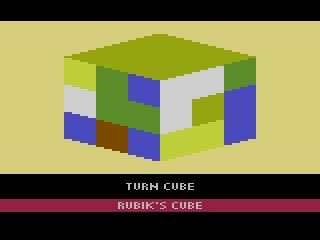
The only problem with 3-D Rubik's Cube is that the game is just as tedious as the real world puzzle. Why would players waste their time screwing around with a simulated puzzle (especially with the awkward controls) when they could just pick up the real thing? Rubik's Cube 3-D is proof that just because you can digitize something doesn't necessarily mean you should. It appears that Atari may have been reconsidering releasing 3-D Rubik's Cube as a standalone cart due to them owning the license to the Rubik's name, but later decided to simply rename Atari Video Cube instead.
| Version | Cart Text | Description |
| ?/??/83 | Rubik's Cube EPROM
Cartridge |
Final Version |

